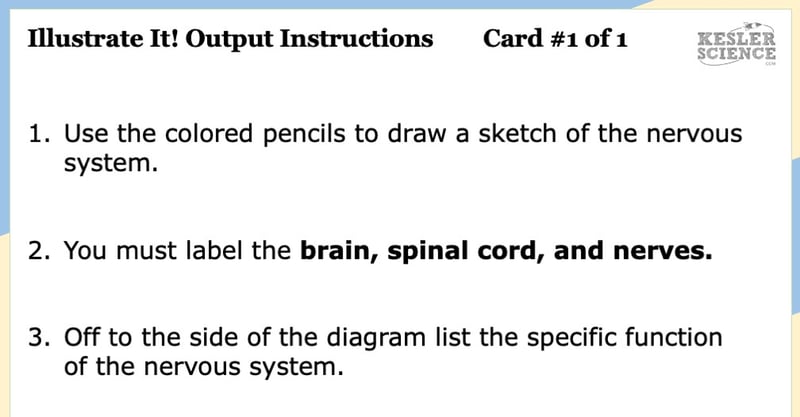Nervous System Lesson Plan – A Complete Science Lesson Using the 5E Method of Instruction
By the end of this lesson plan about the nervous system, students will be able to identify the main functions of the nervous system and how it is structured. They'll also be able to identify the main organs associated with this system. Each of our lessons is designed using the 5E method of instruction to ensure maximum comprehension by the students. This well-thought out unit does the heavy lifting, giving teachers easy-to-implement, highly engaging lesson plans.
This blog will walk you through each of the steps and activities of the Nervous System 5E Lesson Plan.
ENGAGEMENT
Objective Introduction
At the beginning of the lesson, the class will do a Think-Pair-Share to discuss the objective.
Class Activity
- Point out the vocabulary on the Word Wall and ask students to tell you what they already know about the nervous system.
- As your students watch the provided video, have them look for the two parts of the nervous system and their differences.
Student Activity
- What are the two main parts of the nervous system? (central and peripheral)
- What are the main parts of each system? Central Nervous System is made of the brain and spinal cord and Peripheral Nervous System is made up of the nerves.)
- What is a nerve cell called? (neuron)
- What types of nerve cells carry the message toward the brain? (sensory) Away from the brain (motor)
- Tell students they will be learning about the nervous system and the parts of the body connected to it.

The teacher will help to clear any misconceptions about the nervous system. A major misconception is that students do not understand that nerve cells do not actually touch each other as they send messages along a pathway.
Estimated Class Time for the Engagement: 20-30 minutes
EXPLORATION
With nine stations in total, you can introduce the nervous system to your middle school students in a variety of ways! Four of these stations are considered input stations where students will learn new information about the nervous system, and four of the stations are output stations where students will be demonstrating their mastery of the lesson's material. A bonus station offers challenges for your early finishers and independent learners. You can read more about how I set up the station labs here.
Watch It!
At this station, students will be watching a short video explaining the nervous system. Students will then answer questions related to the video and record their answers on their lab station sheet. For example: Explain the difference between the two main structures of the nervous system. Describe the differences and location of the cerebellum and the cerebrum. Briefly summarize how information can flow to and from the distant parts of the body, and then back to the brain.
READ IT!
This station will provide students with a one-page reading about the role of a neurologist. There are four follow-up questions that the students will answer to demonstrate their comprehension of the reading material.
Explore It!
Students will be working in pairs to better understand the nervous system. In this station, students will be observing diagrams pertaining to the nervous system. As they explore, students will record their observations on their lab sheet.
Research It!
The research station will allow students to explore an interactive webpage that has students take a scientific approach to understanding the nervous system. Students will be instructed to complete a few tasks and record answers on their lab sheets.
Organize It!
Students at this station will match the sets of cards. Students will read a series of cards and will match the descriptions to their correct locations on the diagram. Once students have completed their organization, the teacher will check their understanding.
Illustrate It!
Your visual students will love this station. Students are to create and label a diagram that shows the structures of the nervous system.

Write It!
Students who can answer open-ended questions about the lab truly understand the concepts that are being taught. At this station, the students will be answering three task cards: Explain in your own words what the nervous system is and does. Provide two situations in which the nervous system works in conjunction with another body system. Describe the main organs and components of the nervous system.
Assess It!
The Assess It station is where students will go to prove mastery over the concepts they learned in the lab. The questions are set up in a standardized format with multiple choice answers. Some questions include: Which is not a part of the nervous system? Which is not true about the human brain? _____ allow the flow of electrical impulses, or signals, to and from the brain. The nervous system works directly with the ______ system to control the expanding and contracting or our lungs.

Challenge It! - Bonus Station
Early finishers and advanced students will love the extension activities in this station. Four activity choices offer them ways to expand their learning through mini-games and mini-projects.
Estimated Class Time for the Exploration: One or two 45-minute class periods
EXPLANATION
The explanation activities will become much more engaging for your class once they’ve completed the exploration station lab. During the explanation piece of the lesson, the teacher will be clearing up any misconceptions their students may have about nervous system with a variety of materials. These materials include on-level and modified versions of the interactive presentation (may be used individually or projected), anchor charts, and paper or digital interactive notebook activities. If you have students that need modified notes, the 5E lessons come equipped to help give every student access to the lesson.
Interactive notebook samples: Above-left is a digital INB activity slide; above-right is an example of the paper INB activities.
The students will also be interacting with their journals while taking notes from the PowerPoint. If you have students that need modified notes, the 5E lessons come equipped to help give every student access to the lesson.
Estimated Class Time for the Exploration: Two or three 45-minute class periods
ELABORATION
The elaboration section of the 5E method of instruction gives students choices that allow them to prove they’ve mastered the concepts behind the lesson. When students are given a choice, they’re much more enthusiastic and invested in the project than they are when their teachers choose their projects for them. There are a total of nine choices to demonstrate understanding of the nervous system. A separate set of choices that offer more teacher support are also available for students that need them. Rubrics guide students to doing their best work and assist in grading.

Estimated Class Time for the Elaboration: Two or three 45-minute class periods (can also be used as an at-home project)
EVALUATION
The final piece of the 5E model is to evaluate your students' comprehension. Included in every 5E lesson is a homework assignment, assessment, and modified assessment. Research has shown that homework needs to be meaningful and applicable to real-world activities in order to be effective. When possible, I like to give open-ended assessments to truly gauge the student’s comprehension.
Estimated Class Time for the Elaboration: One 45-minute class period
DOWNLOAD THE FULL LESSON NOW
Download Over $100 in FREE Resources
For Middle School Science
Simply create a login below and gain immediate access to a selection of our Kesler Science product line worth $100 - for FREE. There's a full version of every product type! You'll also join tens of thousands of middle school science teachers who receive timely tips and strategies straight to their inbox.







